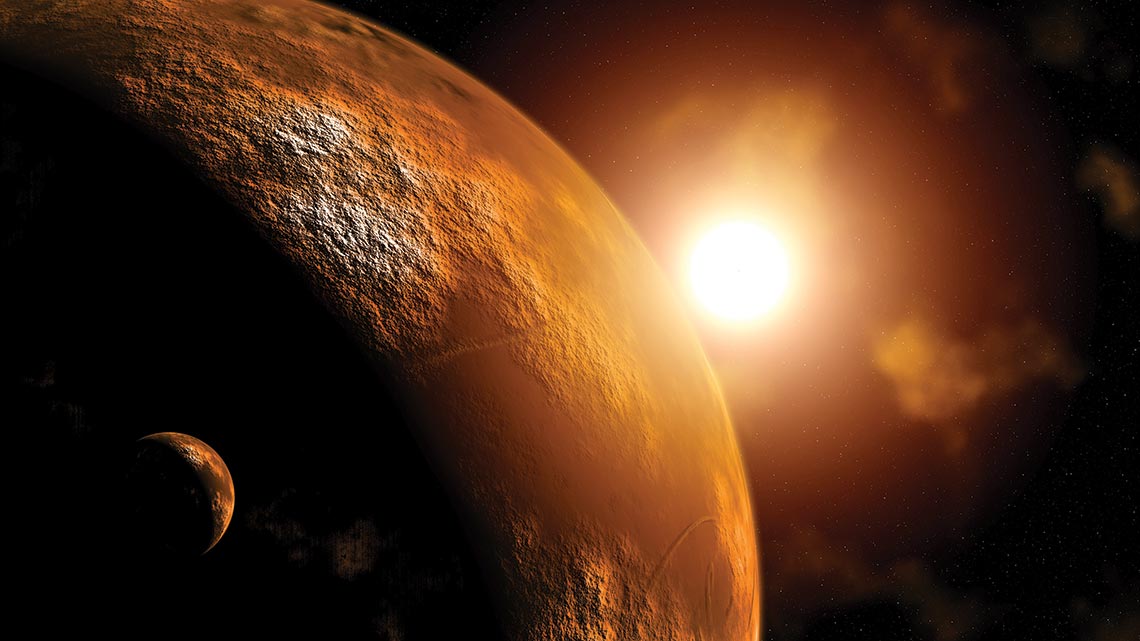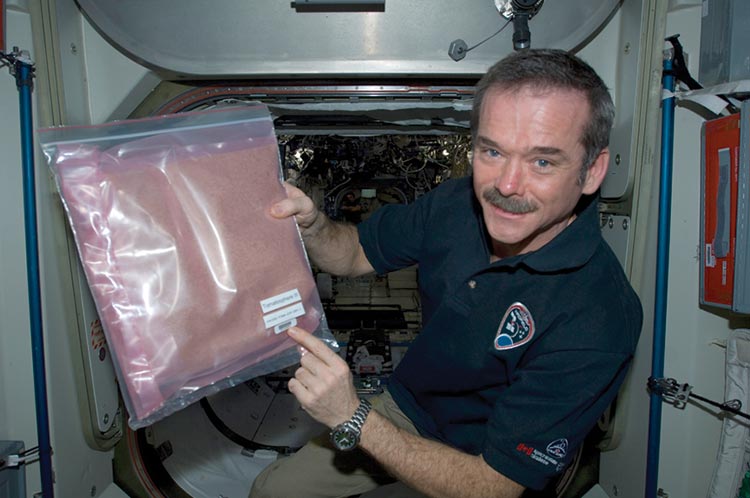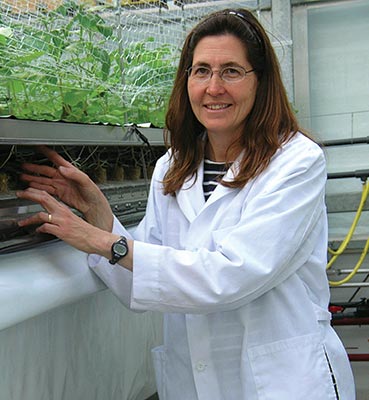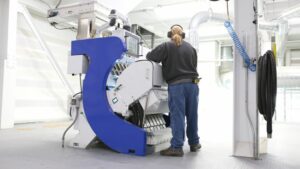Research in space brings home real benefits to agriculture and the seed industry. Explore the possibilities.
Outer space and seeds are not often thought of as going hand-in-hand, but new technologies developed for space exploration are increasingly having an important influence on agriculture and its industries.
How soon humans will colonize Mars is debatable, says Robert Ferl, a University of Florida professor in the Horticultural Sciences Department. Space biology is one of Ferl’s research interests, and while colonizing the red planet might be a ways off, he says humans will be there one day, and we’ll be farming there when we do.
“When humans move in any significant way, we have to take our agriculture with us,” Ferl says. “It is simply a necessity in providing support for productive human life. Having plants around, rather than existing in an artificial, sterile environment, makes a lot of difference for the human animal.”
Retired astronaut Robert Thirsk agrees. Thirsk holds the Canadian records for the longest space flight (187 days, 20 hours) and the most time spent in space (204 days, 18 hours).
“Living aboard a spacecraft is not like staying at a five-star hotel,” he says. “It is functional and rustic. Most of my crew’s food was freeze-dried or thermal-stabilized. While the pre-packaged processed food we ate was nutritious, it was not a home-cooked meal. During our six-month stay aboard the International Space Station, my crew looked forward to the arrival of cargo vehicles. The ground personnel would load fresh fruit and vegetables as they closed the vehicle hatches just before launch. They knew how much we missed fresh food.”
Thirsk shares that the plants also provide psychological support for the crew. “During my expedition, I particularly enjoyed performing biology experiments,” he says. “In a stark, submarine-like environment, caring for plants and animals served as my emotional connection with life on Earth. I imagine that future crews will enjoy tending gardens aboard a spacecraft on its way to Mars or on the planetary surface.”
Mike Dixon, who is the director of the Controlled Environment Systems Research Facility at the University of Guelph, is optimistic that we’ll get to Mars in the next 15 or 20 years, and the more farming knowledge we have when we get there, the better.
Dixon collaborated with Thirsk to help create the Tomatosphere program, which exposes tomato seeds to space conditions to see if they will germinate afterward. The seeds are then sent to schools so students can try and grow them and immerse themselves firsthand in the cause of space exploration.
“Since 2000, when we started this, more than 3 million students in Canada have participated,” Dixon says. “In 2013, we did get into space and Chris Hadfield brought the seeds back, and they’re being distributed right now to more than 18,000 classrooms.” Hadfield is the now-retired Canadian astronaut who was the first Canadian to walk in space and went on to become the commander of the International Space Station.
Getting the next generation interested in space and its relation to agriculture is vital, Dixon notes. Doing so will not only get young people involved in agriculture here on our home planet, but will ultimately ensure a bright future for Canada’s involvement in space exploration, he says.
“I’ve stood in front of a classroom of 10-year-olds and told them the horticultural specialist who will be on the first trip to Mars is in Grade 3 right now,” Dixon shares. “You could hear a pin drop in that room.”
Most recently the First-the Seed Foundation, a not-for-profit organization established in 2008 by the American Seed Trade Association to inform today’s consumers and tomorrow’s workforce about the importance of the seed industry, signed onto the Tomatosphere program as program administrator in the United States.
First-the Seed Foundation representative Ann Jorss explains that classrooms are sent two packages of seeds. The class grows out the seeds and records and submits their results online. Once the results are submitted online, they students will learn which set of seeds were in space and exposed to different stresses, Jorss says, noting that supporters of First-the Seed Foundation are thrilled to be a part of the program.
Colonizing Mars
A new collaboration between Syngenta and PlantLab, which is based in the Netherlands, aims to help bring even more plant potential to life for growers, according to Syngenta. PlantLab’s technology has even caught the eye of the Mars One project — the brainchild of Dutch entrepreneur Bas Landorp. The $6-billion project is intended to one day create a human colony on Mars.
PlantLab’s core business is plant growth in controlled environments, without daylight, using a unique and patented combination of climate control and LED systems, based on mathematical models. PlantLab’s know-how and technology have a wide range of applications, including plant breeding and urban horticulture.
“The agreement with PlantLab will allow us to discover new ways to make a step-change for growers,” explains Robert Berendes, Syngenta head of business development. “Ultimately, it helps us build a deeper understanding of how to grow more from less. The data we’ve seen so far are compelling.”
Dixon isn’t surprised that such initiatives are being undertaken, and notes they often lead to radical changes in the way humans conduct themselves in the agricultural realm. The research facility regularly collaborates with industry, the Canadian Space Agency and space agency partners around the world, including the U.S. National Aeronautics and Space Administration (NASA). Research projects are carried out with one long-term goal in mind — sending human beings to other planets.
Research done at the Guelph facility has had enormous technological implications for agriculture for many years, even though the public often doesn’t realize it. The facility’s most successful commercialization of its research has been in biological filtration of indoor air to combat sick building syndrome, Dixon notes.
“The sensor technologies we’re developing for recycling water — those are the sorts of things that come out of here routinely and get integrated into common practices in the greenhouse industry,” Dixon says. “Virtually every agricultural jurisdiction in the world is legislated to mitigate its runoff, particularly fertilizers, pesticide residues and that sort of thing.
“That will be tomorrow’s leading story, finally solving that environment control issue that will help us maintain environmental quality related to agricultural activities around the world
The facility at the University of Guelph is comprised of 24 sealed environment chambers, including 14 variable-pressure plant growth hypobaric chambers capable of sustaining a vacuum. Staff have extensive experience in the fields of plant physiology, environment analysis and sensor technology. It’s all designed to help humans grow plants in adverse conditions, including conditions with no soil, no natural light and very little available water.
Space Technology in Action
At the Alberta Agriculture and Rural Development Crop Diversification Centre in Brooks, Alberta, researchers are determining whether aeroponic production of seed potatoes represents the future for the seed potato industry.
Potato research scientist Michele Konschuh is leading the evaluation of a commercial aeroponic production system for seed potatoes. The technology being studied is the Vital Farms Potato Incubator PIP-200, an aeroponic seed potato production system from NorthBright Technologies in Chicago. The system is designed to optimize the yield and quality of seed potato mini-tubers. Konschuh and her team are harvesting their fourth round of tubers from their greenhouse.
The tubers are grown suspended in air and fed through misting. It’s a technology that has its contemporary roots in space exploration, says Peter VanderZaag of Ontario’s Sunrise Potato Storage.
VanderZaag serves on the board of trustees of the International Potato Center (CIP), which works to achieve food security, well-being and gender equity in root and tuber farming and food systems in the developing world. He has taken a keen interest in aeroponic potato production since he used to work as a CIP scientist and university professor in Asia. One of his former graduate students led a Chinese project that used aeroponic technology to grow mini-tubers after a devastating earthquake in China’s Sichuan province in 2008.
“NASA, back in the 1980s, wanted to have people living on Mars and the moon,” explains VanderZaag. “Their research focused on how we could get plants to grow in air. This translated into many scientists thinking about how they could apply this to growing plants here on Earth, where we have to deal with pathogens which are detrimental to many crops, including potatoes.”
Konschuh hopes the technology will allow researchers to grow significantly more seed potatoes than is currently possible using traditional greenhouse methods. “In a regular greenhouse, we get an average of one to five tubers per plant in potting mix,” Konschuh says. “In the aeroponic system, we’re aiming to get 10 times more than that.”
Seeing such practical, earthly applications of technology designed for use by astronauts always bring a smile to Dixon’s face. “Everything we do is devoted to that technical mission of going to the moon, or Mars, and growing plants for human life support,” Dixon says. “That’s the technical pull, but the driver is the technology transfer opportunities and commercialization opportunities for our industry partners in terrestrial agri-food.”
Technology Transfer
Dixon points out that the research is a necessity if humans are going to make it to Mars by the 2030s – a mission NASA is already planning. “With the agency laser-focused on a path to Mars, work to develop the technologies astronauts one day will use to live and work on Mars has already begun,” NASA reports.
That technology includes a variety of devices already developed by Dixon and his team, such as new sensor technologies, novel research lighting systems (including LED lights that are five times more intense than the sun), environmental control algorithms, disinfection protocols that don’t leave toxic residues and atmosphere management. The list is virtually endless. Such technologies are ripe for use in the agriculture industry. Dixon and his staff have partnered with Syngenta to create controlled-environment chambers currently in use in North Carolina, he notes.
Syngenta along with many other seed and agricultural businesses have taken a keen interest in evaluating plant responses to a range of stressful conditions that will become more important as climate change alters growing conditions on Earth and the world population is expected to hit 9 billion by 2050.















